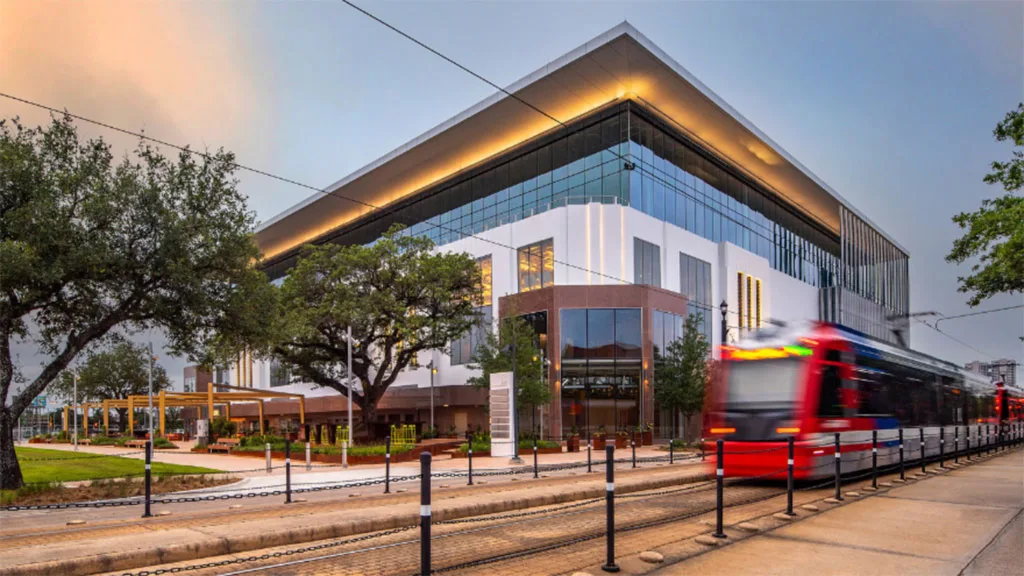The adaptive reuse concept is being adopted across the globe to repurpose abandoned buildings to iconic projects. An exemplary case of adaptive reuse is the iconic Sears department store located in Midtown Houston, which has been transformed into “The Ion.”
Repurposing Midtown Houston’s Iconic Sears Store
In the heart of Midtown Houston, a beloved Sears department store, with a rich 80-year history in the community, remained vacant and unused. Its original art deco design, historic corners, and ornate tilework were concealed behind boarded-up windows. After Sears closed its doors in January 2018, Rice Management Company (RMC), a long-standing property investor of nearly a century, reacquired the store and its adjacent three acres.
The Birth of The Ion:
Just one year after Sears closed its doors for the last time, RMC, in collaboration with the City of Houston, unveiled plans for an extensive renovation project to transform the historic retail building into a hub for innovation known as “The Ion.” This ambitious project aimed to catalyse the development of a thriving innovation district. The Ion’s redesign included Class A office spaces, shared work areas, classrooms, a 300-seat forum, a prototyping lab, and maker spaces. This transformation breathed new life into an outdated and defunct property, creating a community-centred nucleus of innovation.
The Adaptive Reuse Approach For The Project
In line with the adaptive reuse approach, the City of Houston and RMC formed an agreement to allocate funds to various community programs, such as affordable housing and the advancement of minorities in the tech industry. This agreement prompted a reevaluation of the interior spaces’ design. Gensler, a renowned design firm, was enlisted to reimagine The Ion’s interior spaces. The result is a multi-layered yet accessible environment that emphasises openness, minimises barriers, and leverages transparent materials.

Preserving the Building’s Integrity:
The project team was dedicated to preserving the building’s original structure, resulting in a raw and industrial atmosphere within the renovated building. This approach conveys a sense of opportunity and potential. While maintaining the existing structure, Gensler introduced new materials, furniture, and lighting to connect the different tenants and programs. This design makes the building appear exposed and excavated, allowing internal creativity and innovation to take the spotlight.
The Ion Prototyping Lab (IPL):
The Ion’s ground level houses the Ion Prototyping Lab (IPL), designed as an open experimentation area accessible to anyone with innovative ideas. Equipped with laser cutters, CNC mills and lathes, 3D printers, electronics assembly devices, and other small-batch manufacturing tools, the IPL provides entrepreneurs, startups, and makers with access to equipment, training, and technical support.
Diverse Mix of Tenants:
The Ion’s commitment to transparency and collaboration extends to its diverse mix of tenants, including The Chevron Technology Ventures (CTV), a division of an oil-and-gas company that supports energy-related tech startups. CTV was seeking a distinct space separate from its main campus where outside collaborators could engage more freely. The Ion proved to be the ideal location for CTV.
Incorporating Chevron’s Identity:
Upon entering CTV’s space, guests are greeted by a Chevron-branded biophilia wall, adorned with various artifacts showcasing Chevron’s rich history in the energy industry. Multiple meeting rooms are available for internal teams to collaborate, vendors to conduct demos, and case competitions, recruiting events, and more. The design also includes a coffee bar and social area to encourage community-building and chance meetings. As a result, CTV’s new “third place” office serves as a model for a new way of working within Chevron’s workplace of the future strategy.

Preserving Historical Elements:
Despite its transformation, remnants of the building’s historical significance are still visible today. Visitors who once shopped in the 80-year-old department store can identify historic elements such as an antique clock and the terrazzo flooring. The iconic Sears sign was carefully preserved, with ongoing efforts to give it new life. The Ion, intended to be the heart of a larger innovation district, is poised to further establish Houston as a destination for start-up companies, potentially attracting investments in new technologies.
What is Adaptive Reuse?
Adaptive reuse is a sustainable architectural and design approach that involves repurposing existing buildings or structures for new operational needs rather than demolishing them and building something entirely new.
Advantages of Adaptive Reuse:
- Preserving cultural heritage.
- Reduced zoning and regulatory hurdles.
- Flexible repurposing for various uses
- Utilizes existing infrastructure
- Reduced land consumption
- Minimizes construction waste
- Reduced Construction Time
To know more about adaptive reuse, visit- https://constrofacilitator.com/adaptive-reuse-advantages-applications-across-the-globe/
Conclusion:
The Ion’s transition from a retail centre to a dynamic innovation hub is a testament to Houston’s commitment to nurturing startups and technological advancements. With its diverse tenant mix, open design, and respect for the past, The Ion serves as a model for adaptive reuse and forward-thinking design, fostering the city’s growth as a technology and innovation hub.
References- Bdcnetwork.com, gensler.com

